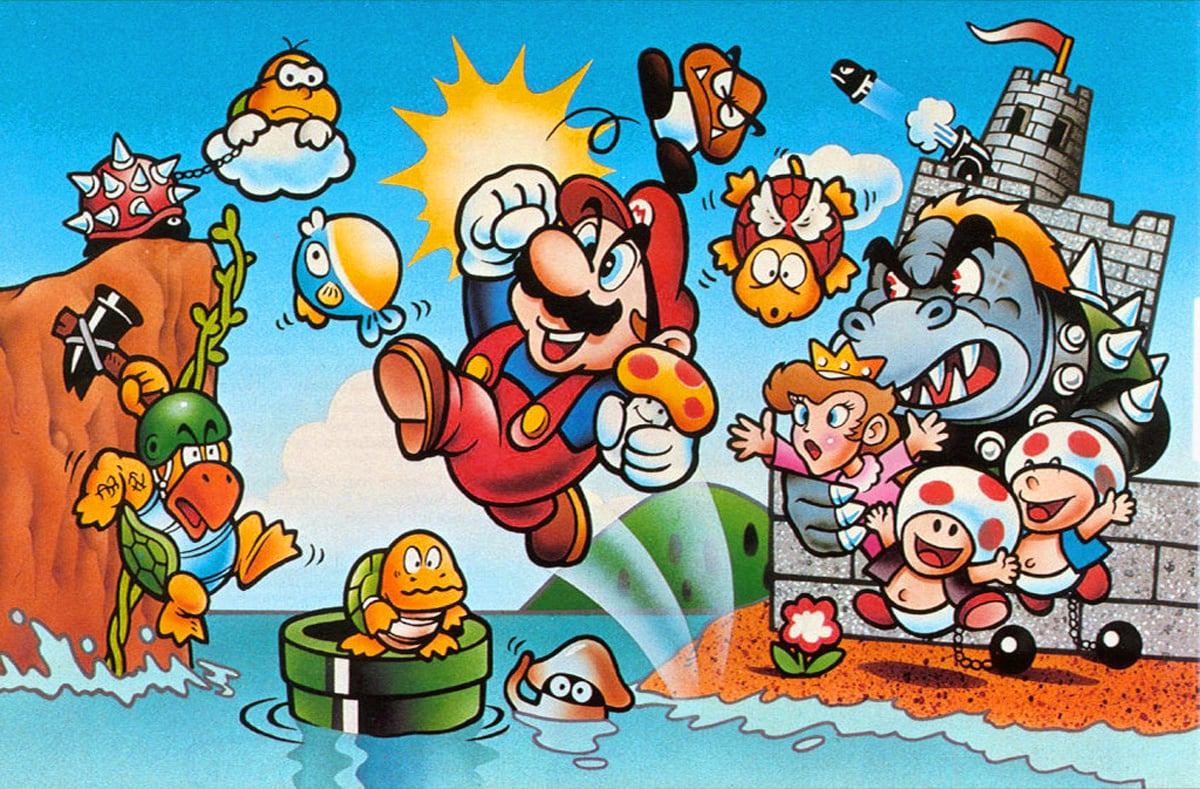The Evolution of Gaming Consoles: A Timeline

"We knew we had something that would break records and make history. What we didn't know was that we were creating an industry that would take over the world of entertainment."
These were the words of renowned inventor Ralph Baer, often referred to as the "father of video games". Ralph was responsible for bringing video games from the claustrophobic corridors of the arcade to the comfort of the everyday household. His invention the "brown box" (later rebranded as the Magnavox Odyssey) was a slam-dunk commercial success and revolutionized the entertainment industry in a way that had not been done since the Lumiere brothers unveiled the first public motion picture in 1865.
Today the invention of the Magnavox definitively marks the inception of modern gaming and serves as a precursor to every innovation that followed. Since Baer's groundbreaking creation the industry has morphed and evolved with every new generation of consoles. This timeline explores the fascinating and dynamic evolution of video game consoles throughout the years and delves into the lasting impacts they have had on the gaming industry as a whole:

The First Generation (1972-1977)
Magnavox Odyssey (1972)
The Magnavox Odyssey, released in 1972, was the first home video game console. It was created by Ralph Baer, who is often referred to as the "Father of Video Games." Baer, an engineer, had the vision of creating a device that would allow people to play games on their television sets.
The purpose of the Magnavox Odyssey was to bring the arcade gaming experience into people's homes. At the time, arcade games were extremely popular, but they could only be played in arcades or other public places. The Magnavox Odyssey allowed people to enjoy video games in the comfort of their own homes, which was a groundbreaking concept at the time.
Overall, the Magnavox Odyssey played a crucial role in the evolution of gaming consoles by introducing the idea of home gaming and paving the way for future consoles to come.

Atari Pong (1975)
Atari Pong was the first commercially successful video game console that played a significant role in sparking the arcade gaming craze. It featured the popular game Pong, which became a sensation.
In the end, the Atari sold over 35,000 Pong machines, making it a hit among consumers. The success of Atari Pong paved the way for the evolution of gaming consoles and laid the foundation for the future of the gaming industry.
The Second Generation (1976-1983)
Atari 2600 (1977)
The Atari 2600 played a crucial role in popularizing home gaming consoles, bringing the gaming experience from arcades into the living room.
One of the key innovations of the Atari 2600 was the introduction of interchangeable game cartridges. This allowed gamers to expand their gaming library without needing to purchase an entirely new console.
The Atari 2600 is also remembered for its collection of iconic games that became synonymous with the console. Notably, games like Space Invaders and Pac-Man were incredibly popular and contributed to the industry's success. These games have since become timeless classics and part of gaming history.
The Third Generation (1983-1992)
Nintendo Entertainment System (NES) (1983)
The Nintendo Entertainment System (NES), released in 1985, played a pivotal role in revitalizing the gaming industry following the devastating video game crash of 1983.
One of its major contributions was the introduction of beloved franchises such as Super Mario Bros. and The Legend of Zelda. These iconic games, with their immersive gameplay and captivating storylines, captured the hearts of millions of gamers worldwide.
According to Sam Stone, CBR:
"Mario quickly became an international icon [...] and prove[d] instrumental in salvaging the North American video game industry, which had completely imploded just two years prior."

Additionally, the NES gained widespread recognition for popularizing the use of game controllers equipped with directional pads. This innovative design provided users with precise control over characters and enabled smoother navigation within the game.
The NES's success and influence on the gaming industry cannot be overstated, as it not only rejuvenated a struggling market but also established a foundation for future gaming consoles and franchises.
Sega Master System (1985)
The competitor to the NES, which is the Nintendo Entertainment System, was a gaming console that emerged in response to the growing popularity of the NES. This rival console offered a unique gaming experience with its own set of features and gameplay options. One of the notable advancements it brought to the market was the introduction of 8-bit graphics. This meant that the console had the ability to display more detailed and visually appealing game graphics, enhancing the overall gaming experience for players.
In addition to its improved graphics, this competitor console also boasted enhanced sound capabilities. The developers of this console recognized the importance of audio in creating an immersive gaming environment, and thus, they worked on delivering high-quality sound effects and music. This heightened audio experience further contributed to the overall enjoyment and engagement of players.

While the NES dominated the gaming market in North America and Japan, this rival console found its popularity in other regions, particularly Europe and Brazil. The console's unique features and gameplay options captivated gamers in these regions, leading to a loyal fan base and significant sales figures. In Europe the Master System sold near to 7 million units which was remarkably close to Nintendo's sales figure of 8.3 million for their powerhouse console. However, the Master System struck a chord with the people in Brazil and became a local sensation with 8 million copies sold and counting – Brazil is the only country in the world where the Master System is still being produced and sold. In comparison Nintendo was only able to sell 770 thousand consoles in regions outside of North America, Europe and Japan.
Overall, this competitor console brought forth advancements in both graphics and sound capabilities, offering a compelling alternative to the NES. Its popularity in Europe and Brazil demonstrated its ability to resonate with gamers outside of the dominant markets, showcasing its unique appeal and success in those regions.
The Fourth Generation (1987-1996)
Super Nintendo Entertainment System (SNES) (1990)
During its time, the Super Nintendo Entertainment System (SNES) offered significant improvements in both graphics and sound capabilities compared to its predecessor, the NES. The SNES featured a more advanced 16-bit processor, allowing for more detailed and visually appealing graphics. Additionally, the system's audio capabilities were greatly enhanced, resulting in richer and more immersive soundtracks and sound effects.
One of the key factors that contributed to the SNES's immense popularity was its impressive library of games. It introduced some of the most iconic and beloved titles in gaming history, including Super Mario World and The Legend of Zelda: A Link to the Past. Super Mario World showcased the SNES's graphical capabilities, featuring vibrant and colorful environments, intricate level designs, and smooth animations. The Legend of Zelda: A Link to the Past, on the other hand, offered a deep and immersive adventure, introducing players to a sprawling and interconnected world filled with memorable characters and challenging puzzles.

The SNES also faced fierce competition from Sega Genesis, which was released around the same time. This rivalry between the two consoles resulted in intense marketing campaigns and a constant push to outdo one another. The competition between the SNES and Sega Genesis was not only limited to hardware capabilities but also extended to the games they offered. Both consoles had their exclusive and highly acclaimed titles, leading to heated debates among gamers about which console had the better library.
In conclusion, the SNES's improved graphics and sound capabilities, along with its impressive lineup of games, contributed to its status as one of the most beloved and influential gaming consoles of all time. Its fierce competition with Sega Genesis further intensified the rivalry between the two consoles and fueled the ongoing battle for dominance in the gaming industry.
Sega Genesis (1988)
The Sega Genesis introduced impressive 16-bit graphics, leading to a significant upgrade in visual quality compared to its predecessor. Additionally, it boasted improved sound capabilities, delivering enhanced audio experiences for gamers.
This console also faced fierce competition from the Nintendo Entertainment System (NES) and later the Super Nintendo Entertainment System (SNES). It engaged in the console wars, offering an alternative gaming experience to Nintendo's offerings.
Additionally, the Sega Genesis was home to a wide range of popular games that became iconic in gaming culture. One of its most notable franchises was Sonic the Hedgehog, which quickly became a beloved mascot for Sega. Additionally, the Genesis also offered gamers the opportunity to enjoy the Mortal Kombat series, known for its intense fighting gameplay and controversial depiction of violence.

The Fifth Generation (1993-2005)
Sony PlayStation (1994)
The release of the Sony PlayStation in 1994 had a profound impact on the gaming industry. Here are some key points regarding the significance of this revolutionary console:
- CD-based games: With the Sony PlayStation's introduction of CD-based games, it brought about a fundamental shift in gaming technology. The console's ability to play games on CDs rather than cartridges offered developers more storage space to create larger, more visually stunning games.
- Popularized 3D graphics: The Sony PlayStation played a crucial role in popularizing the use of 3D graphics in the gaming world. By pushing the boundaries of technology, it allowed game developers to create visually immersive and realistic environments, ushering in a new era of graphics in gaming.
- Immersive gameplay experiences: The console's powerful hardware capabilities opened up possibilities for more immersive gameplay experiences. Players could now become fully engaged in captivating virtual worlds, thanks to improved visuals, sound quality, and enhanced game mechanics.
- Iconic franchises: The Sony PlayStation introduced several iconic franchises that have become industry staples. One notable example is the "Final Fantasy" series, which gained widespread popularity and evolved into one of the most successful RPG franchises. The console also brought us "Metal Gear Solid," a groundbreaking stealth-action game and "Crash Bandicoot" PlayStation's very own mascot designed to rival the likes of Mario and Sonic in the console wars.

The PlayStation's arrival in 1994 disrupted the gaming landscape, leaving an indelible mark on the industry. In the words of Shawn Layden (former CEO of Sony Interactive Entertainment):
"It spoke differently. It pitched differently [...] PlayStation really overturned the tea table. And everyone had to deal with the world that Sony was going to create after that.”
This new gaming world would be defined by the flagship features of Sony's revolutionary console. The new CD-based format, the popularization of 3D graphics as well as the focus on immersive gameplay experiences, and the birth of many iconic franchises ensured that the PlayStation would be remembered as a turning point in the history of gaming.
Nintendo 64 (1996)
The Nintendo 64 revolutionized the gaming industry by introducing 3D gaming experiences. With its innovative analog stick controller, players were able to have more precise and immersive control over their in-game characters.
The console featured groundbreaking games like Super Mario 64 and The Legend of Zelda: Ocarina of Time. Super Mario 64, one of the Nintendo 64's flagship titles, set a new standard for 3D platforming games. It showcased the console's capabilities by providing an expansive and interactive 3D world for players to explore. Similarly, The Legend of Zelda: Ocarina of Time pushed the boundaries of what was possible in 3D adventure games, cementing its place as one of the greatest video games of all time.
Finally, the Nintendo 64 was also known for its innovative multiplayer capabilities. Unlike previous consoles, the Nintendo 64 featured four controller ports, allowing friends to gather together and play games cooperatively or competitively in the same room. This local multiplayer experience brought a new level of social interaction and fun to gaming.
The Sixth Generation (1998-2013)
Sega Dreamcast (1998)
The last console by Sega was a significant milestone in gaming history. It introduced the concept of online gaming and was one of the first consoles to have a built-in modem, allowing players to connect with others from around the world. This innovation revolutionized multiplayer gaming, as it eliminated the need for local multiplayer and opened up a whole new world of interactive experiences.
The console boasted several innovative features that set it apart from its competitors. It had a sleek and modern design, with ergonomic controllers that offered a comfortable and immersive gaming experience. The console also supported high-quality graphics and sound, providing players with stunning visuals and realistic audio effects.
Despite its groundbreaking features, the console faced tough competition from other gaming giants in the industry. Competitors such as Sony's PlayStation and Microsoft's Xbox dominated the market, offering their own online gaming platforms and exclusive titles that attracted a large player base. Sega struggled to gain a significant market share, as gamers were already heavily invested in their existing consoles and ecosystems.
Ultimately, the last console by Sega was unable to compete against its formidable rivals, and Sega made the difficult decision to exit the hardware business altogether. However, its impact on the gaming industry cannot be denied. The introduction of online gaming and built-in modem paved the way for future consoles to adopt similar features, leading to the thriving online multiplayer gaming experiences we enjoy today.
PlayStation 2 (2000)
The PlayStation 2 changed the gaming industry with its immense popularity and sales success. It surpassed all other gaming consoles in terms of units sold, making it the undisputed leader in the market.
Apart from gaming, the PlayStation 2 also stood out as a versatile entertainment system. It was the first gaming console to incorporate DVD playback capabilities, allowing users to enjoy movies, TV shows, and other forms of media conveniently on their gaming console.

To add to this, PlayStation 2 boasted an extensive and diverse library of games, catering to a wide range of interests and preferences. Whether players enjoyed action-packed adventures, immersive role-playing experiences, mind-bending puzzles, or intense sports simulations, the PlayStation 2 offered a game for everyone. Its game library became a defining factor of its success, solidifying its place as an all-inclusive gaming platform.
The Seventh Generation (2005-2013)
Xbox 360 (2005)
The Xbox 360, released in 2005, brought about a new era in gaming with its cutting-edge features and capabilities. It revolutionized the gaming industry by introducing high-definition gaming and online multiplayer capabilities, providing gamers with a more immersive and interactive gaming experience.
One of the standout features of the Xbox 360 was its introduction of achievements. This innovative system allowed players to earn virtual rewards for reaching specific milestones or completing certain objectives within games. These achievements added a new layer of motivation and competitiveness among gamers, driving them to explore more of the game's content and push their skills to the limit.
In addition to achievements, the Xbox 360 also popularized the concept of downloadable content (DLC). This allowed players to expand their gaming experience by purchasing and downloading additional game content such as extra levels, characters, or features. This gave gamers the opportunity to extend the lifespan of their favorite games and continue their adventures even after completing the main storyline.

The Xbox 360 boasted an impressive library of games, featuring popular franchises like Halo and Gears of War. These exclusive titles became synonymous with the console, attracting a dedicated fan base and contributing to the Xbox 360's success.
Overall, the Xbox 360 made a significant impact on the gaming industry by pushing the boundaries of technology and introducing groundbreaking features. It cemented its place as one of the most influential and iconic gaming consoles of all time.
PlayStation 3 (2006)
The PlayStation 3 was released in 2006 and had groundbreaking features like Blu-ray playback, improved graphics, and exclusive games. It had a significant impact on the gaming industry.
The device had the ability to play Blu-ray discs, providing users with high-definition and superior quality video and audio playback. Players could now enjoy their favorite movies, TV shows, and other media content in the best possible format on their home console. This helped evolve the PlayStation from a simple gaming machine to something that the whole family could use and find value in. Sony leaned into this idea even further with the release of their next console. The PlayStation 4 gave users the ability to download and use apps such as Spotify, YouTube and Netflix while also allowing players to surf the web on the console.

To add to this, the PS3 was equipped with advanced graphics capabilities and processing power, allowing for highly detailed and realistic visuals in games, movies, and other applications. This meant that users could experience stunning graphics and smooth performance, enhancing their overall entertainment and gaming experience.
Finally, the device offered a range of exclusive game titles that were specifically designed and optimized to take advantage of its unique features and capabilities. These exclusive games included special features, enhanced graphics, and unique gameplay experiences that were not available on other gaming platforms. This gave users a distinct and exclusive gaming experience that set the device apart from other gaming consoles or devices.
The Eighth Generation (2012-2020)
Wii U (2012)
One major development that was introduced during this time was the concept of second screen gaming with the GamePad. The GamePad was a unique controller that featured a built-in screen, allowing players to have a secondary display for additional game information or even to play certain games independently from the main TV screen. This innovation aimed to enhance the gaming experience by providing new ways to interact with games and access game-related content.
However, despite its innovative features, the GamePad received a mixed reception from both critics and consumers. Some praised the potential it offered for new gameplay experiences, while others criticized it as being cumbersome and unnecessary. Additionally, the GamePad's battery life was often a point of contention, as it required frequent recharging during longer gaming sessions.
Furthermore, the Wii U struggled with limited third-party support, which was a significant drawback for the console. Many popular game developers and publishers were hesitant to invest resources into developing games for the Wii U due to its relatively low sales figures compared to its competitors. As a result, the console's game library lacked the breadth and diversity that gamers had come to expect, leading to diminished interest from potential buyers.
Ultimately, these challenges contributed to the Wii U's transition to the next generation. Nintendo recognized the need to reevaluate their approach and make significant changes in order to remain competitive in the gaming market. This led to the development of the Nintendo Switch, which would address some of the Wii U's shortcomings and introduce a hybrid console that could be used both as a handheld device and a home console. The Wii U's legacy, therefore, served as a stepping stone for Nintendo's future endeavors in the gaming industry.
PlayStation 4 (2013)
The PlayStation 4, released in 2013, brought significant advancements in graphics and processing power, revolutionizing gaming experiences with more realistic visuals and smoother gameplay.
Along with the hardware improvements, the PlayStation 4 introduced a range of social features and streaming capabilities, allowing gamers to share their gameplay experiences with friends and the broader gaming community.
The PlayStation 4 showcased a lineup of critically acclaimed games that became instantly iconic on the platform. Titles like "Uncharted 4" and "God of War" captivated players with their compelling storytelling, stunning graphics, and immersive gameplay. These games left a lasting impact on the gaming industry and solidified the PlayStation 4's reputation as a powerhouse console.

Xbox One (2013)
The Xbox One, released in 2013 as a direct competitor to the PlayStation 4, brought its own set of defining characteristics and achieved significant commercial success. The console showcased powerful hardware, including an eight-core processor and a dedicated graphics processing unit, allowing for stunning visuals and smooth gameplay.
One of the standout features of the Xbox One was its integration with the Kinect motion sensor, which enabled innovative gameplay experiences and voice commands.
Additionally, the console offered a wide range of multimedia capabilities, allowing users to stream movies, TV shows, and music.
The Xbox One also emphasized online multiplayer gaming, with a robust online platform known as Xbox Live. With its strong lineup of exclusive games such as "Halo 5: Guardians" and "Forza Motorsport 7," the Xbox One garnered a dedicated fanbase and achieved commercial success, solidifying its place in the history of gaming consoles.
The 9th Generation (2020-Present)
PlayStation 5 (2020)
The PlayStation 5, released in 2020 and faced significant scarcity upon its release, with high demand far exceeding the available supply. This scarcity created a frenzy among gamers, leading to long waiting times and difficulty in securing a console. The limited availability of the PlayStation 5 only added to its appeal and contributed to the excitement surrounding its release.
The console had been highly anticipated and went on to make a significant impact in the gaming industry. With its powerful hardware and innovative features, the PlayStation 5 achieved remarkable commercial success.
The console boasts an impressive custom eight-core AMD Zen 2 CPU and a powerful AMD RDNA 2 GPU, which allows for stunning graphics and seamless gameplay. One of the defining characteristics of the PlayStation 5 is its ultra-high-speed solid-state drive (SSD), which drastically reduces loading times and enhances the overall gaming experience.
The console also introduced the DualSense controller, which features haptic feedback and adaptive triggers, providing a more immersive and realistic gameplay experience.
Additionally, the PlayStation 5 offers backward compatibility, allowing players to enjoy a vast library of PlayStation 4 games. With its strong lineup of exclusive games such as "Spider-Man: Miles Morales" and "Demon's Souls," the PlayStation 5 has cemented its position as one of the leading consoles in the gaming industry.
Xbox Series X (2020)
Much like the PS5 it is well-documented that the Xbox Series X was in high demand and difficult to find during the initial release period. Many retailers reported selling out within minutes or even seconds of restocking, and online marketplaces saw listings for the console selling at significantly inflated prices due to the limited supply. This craze contributed to the already unstoppable hype train of the new generation consoles and helped to boost the anticipation of the gaming world.
The Xbox Series X has achieved remarkable commercial success. The console is equipped with a custom eight-core AMD Zen 2 CPU and a powerful AMD RDNA 2 GPU, providing exceptional performance and stunning graphics. One of the defining characteristics of the Xbox Series X is its fast loading times and smooth gameplay, thanks to its solid-state drive (SSD).
The console also introduced the new Xbox Wireless Controller, which offers enhanced ergonomics and reduced latency for a more immersive gaming experience.
Just like the PS5 the Xbox Series X introduced a backward compatibility feature, which allowed players to enjoy a wide range of Xbox One games on the Xbox Series X. The Xbox Series X has quickly established itself as a leading console, offering a strong lineup of exclusive games such as "Halo Infinite" and "Forza Horizon 4," making it a favorite among gamers worldwide.
Conclusion
The evolution of gaming consoles has been a remarkable journey, from the simple beginnings of the Magnavox Odyssey to the powerful and immersive consoles of today. Each generation has brought new innovations, improved graphics, and expanded gameplay options, shaping the gaming industry as we know it. As technology continues to advance, it will be exciting to see what the future holds for gaming consoles.
Most Popular Questions About Video Game Console Evolution
1. How did gaming consoles evolve over time?
Gaming consoles have evolved significantly over time, starting from simple Pong-like games to the sophisticated and immersive consoles we have today. This evolution has been driven by advancements in technology, which have allowed for better graphics, more powerful processors, and enhanced gameplay experiences.
2. What was the first gaming console ever created?
The first gaming console ever created was the Magnavox Odyssey, introduced in 1972. It was a simple console that connected to a television and allowed players to play games like Pong and Table Tennis.
3. What were some significant milestones in console evolution?
Some significant milestones in console evolution include the release of the Atari 2600 in 1977, which popularized home gaming; the launch of the Nintendo Entertainment System (NES) in 1985, which introduced iconic games like Super Mario Bros.; and the arrival of the Sony PlayStation in 1994, which brought CD-based gaming to the mainstream.
4. How have graphics in gaming consoles improved over time?
Graphics in gaming consoles have improved dramatically over time. Early consoles had simple, pixelated graphics, while modern consoles can render realistic 3D graphics with high-resolution textures and advanced lighting effects. This improvement in graphics has contributed to more immersive gaming experiences.
5. How has online gaming impacted console evolution?
Online gaming has had a significant impact on console evolution. The ability to connect consoles to the internet has allowed for multiplayer gaming experiences, downloadable content, and regular software updates. Online gaming has also given rise to esports and streaming platforms, further shaping the gaming industry.
6. What are some recent trends in console evolution?
Some recent trends in console evolution include the introduction of virtual reality (VR) gaming, which provides more immersive experiences; the integration of streaming services, allowing players to stream games directly to their consoles; and the focus on cross-platform play, enabling players to compete and collaborate across different console systems.
7. What can we expect from future console evolution?
The future of console evolution holds exciting possibilities. We can expect even more advanced graphics and processing power, improved virtual reality experiences, seamless integration with other devices, and continued innovation in gameplay mechanics. The gaming industry is constantly evolving, and future consoles will likely push the boundaries of what is possible in gaming.





